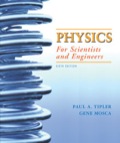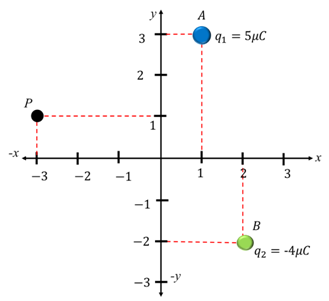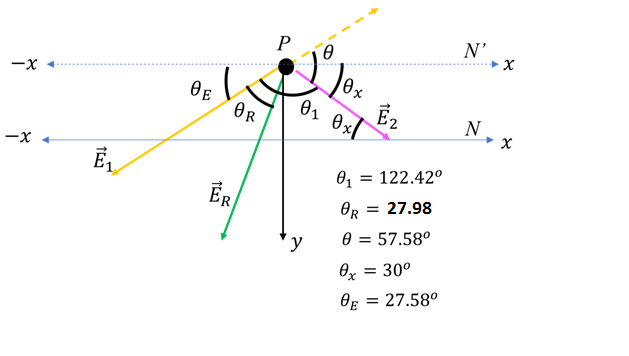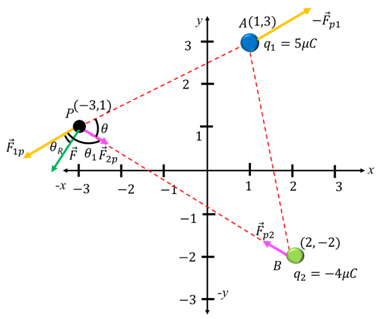
Concept explainers
(a)
The magnitude and direction of the electric field.
(a)
Answer to Problem 45P
The components of the resultant electric field are
The magnitude of the resultant electric field
Explanation of Solution
Introduction:
Electric field,
Also, two similar charges repel each other and opposite charges attract each other with equal and opposite force.
A charge

Figure 1: Two charges q1 and q2 are placed at the given co-ordinates, and the electric fieldis to be determined due to thetwo given charges is to be found at point P.
Now at point A, the positive charge
The distance between points A and B is
The distance between points P and B is
The distance between points P and A is

Figure 2: The field lines due the two charges at point P and the resultant of the field.
Electric field at distance r from a charge q is given by
Cosine law is used to find the angle
Putting the values from equation, we get
Now, to find the resultant angle, just focus on the filed lines shown in Figure 3.

Figure 3: The resultant field
Now the using the parallelogram theorem, we can find the resultant of the field
and
The resultant angle is calculated as below:
In order to find the angle of resultant electric field, trigonometry is used as shown in Figure 4:

Figure 4: The angle of resultant electric field with the x axis
The angle of the
Thus, the
Conclusion:
The components of the resultant electric field is
The magnitude of the resultant electric field
(b)
The magnitude and direction of the force of the proton.
(b)
Answer to Problem 45P
The components of the resultant force is :
The magnitude of the resultant force is
Explanation of Solution
Introduction:
The electric force between two charges
Also, two similar charges repel each other and opposite charges attract each other with equal and opposite force.
A charge
There is an attractive force on the proton due to charge

Figure 5: Forces acting on the proton placed at point P
The resultant force acting on the proton will be:
The direction of the force will be the same as of the field calculated in the previous section.
Conclusion:
The components of the resultant force is :
The magnitude of the resultant force is
Want to see more full solutions like this?
Chapter 21 Solutions
EBK PHYSICS FOR SCIENTISTS AND ENGINEER
- Three charged particles are located at the corners of an equilateral triangle as shown in Figure P19.9. Calculate the total electric force on the 7.00-C charge.arrow_forwardA point charge of 4.00 nC is located at (0, 1.00) m. What is the x component of the electric field due to the point charge at (4.00, 2.00) m? (a) 1.15 N/C (b) 0.864 N/C (c) 1.44 N/C (d) 1.15 N/C (e) 0.864 N/Carrow_forwardAn infinite line of positive charge lies along the y axis, with charge density = 2.00 C/m. A dipole is placed with its center along the x axis at x = 25.0 cm. The dipole consists of two charges 10.0 C separated by 2.00 cm. The axis of the dipole makes an angle of 35.0 with the x axis, and the positive charge is farther from the line of charge than the negative charge. Find the net force exerted on the dipole.arrow_forward
- A particle with charge q on the negative x axis and a second particle with charge 2q on the positive x axis are each a distance d from the origin. Where should a third particle with charge 3q be placed so that the magnitude of the electric field at the origin is zero?arrow_forwardTwo particles with charges q1 and q2 are separated by a distance d, and each exerts an electric force on the other with magnitude FE. a. In terms of these quantities, what separation distance would cause the magnitude of the electric force to be halved? b. In terms of these quantities, what separation distance would cause the magnitude of the electric force to be doubled?arrow_forwardA circular ring of charge of radius b has a total charge q uniformly distributed around it. Find the magnitude of the electric field in the center of the ring. (a) 0 (b) keq/b2 (c) keq2/b2 (d) keq2/b (e) None of these answers is correct.arrow_forward
- A uniformly charged insulating rod of length 14.0 cm is bent into the shape of a semicircle as shown in Figure P 19.21. The rod has a total charge of 7.50 C. Find (a) the magnitude and (b) the direction of the electric field at O, the center of the semicircle.arrow_forwardA rod 14.0 cm long is uniformly charged and has a total charge of 22.0 C. Determine (a) the magnitude and (b) the direction of the electric field along the axis of the rod at a point 36.0 cm from its center.arrow_forwardA very small ball has a mass of 5.00 103 kg and a charge of 4.00 C. What magnitude electric field directed upward will balance the weight of the ball so that the ball is suspended motionless above the ground? (a) 8.21 102 N/C (b) 1.22 104 N/C (c) 2.00 102 N/C (d) 5.11 106 N/C (e) 3.72 103 N/Carrow_forward
- In nuclear fission, a nucleus of uranium-238, which contains 92 protons, can divide into two smaller spheres, each having 46 protons and a radius of 5.90 1015 m. What is the magnitude of the repulsive electric force pushing the two spheres apart?arrow_forwardPanicle A of charge 3.00 104 C is at the origin, particle B of charge 6.00 104 C is at (4.00 m, 0), and panicle C of charge 1.00 104 C is at (0, 3.00 m). (a) What is the x-component of the electric force exerted by A on C? (b) What is the y-component of the force exerted by A on C? (c) Find the magnitude of the force exerted by B on C. (d) Calculate the x-component of the force exerted by B on C. (e) Calculate the y-component of the force exerted by B on C. (f) Sum the two x-components to obtain the resultant x-component of the electric force acting on C. (g) Repeat part (f) for the y-component. (h) Find the magnitude and direction of the resultant electric force acting on C.arrow_forwardThree charged panicles are located at the corners of an equilateral triangle as shown in Figure P23.15. Calculate the total electric force on the 7.00-C charge.arrow_forward
 Principles of Physics: A Calculus-Based TextPhysicsISBN:9781133104261Author:Raymond A. Serway, John W. JewettPublisher:Cengage Learning
Principles of Physics: A Calculus-Based TextPhysicsISBN:9781133104261Author:Raymond A. Serway, John W. JewettPublisher:Cengage Learning Physics for Scientists and Engineers, Technology ...PhysicsISBN:9781305116399Author:Raymond A. Serway, John W. JewettPublisher:Cengage Learning
Physics for Scientists and Engineers, Technology ...PhysicsISBN:9781305116399Author:Raymond A. Serway, John W. JewettPublisher:Cengage Learning Physics for Scientists and Engineers: Foundations...PhysicsISBN:9781133939146Author:Katz, Debora M.Publisher:Cengage Learning
Physics for Scientists and Engineers: Foundations...PhysicsISBN:9781133939146Author:Katz, Debora M.Publisher:Cengage Learning College PhysicsPhysicsISBN:9781305952300Author:Raymond A. Serway, Chris VuillePublisher:Cengage Learning
College PhysicsPhysicsISBN:9781305952300Author:Raymond A. Serway, Chris VuillePublisher:Cengage Learning College PhysicsPhysicsISBN:9781285737027Author:Raymond A. Serway, Chris VuillePublisher:Cengage Learning
College PhysicsPhysicsISBN:9781285737027Author:Raymond A. Serway, Chris VuillePublisher:Cengage Learning Physics for Scientists and Engineers with Modern ...PhysicsISBN:9781337553292Author:Raymond A. Serway, John W. JewettPublisher:Cengage Learning
Physics for Scientists and Engineers with Modern ...PhysicsISBN:9781337553292Author:Raymond A. Serway, John W. JewettPublisher:Cengage Learning





